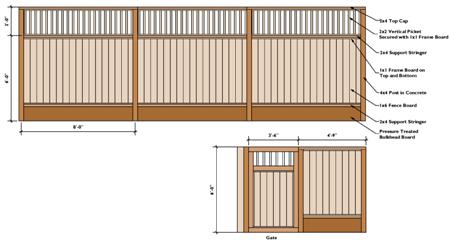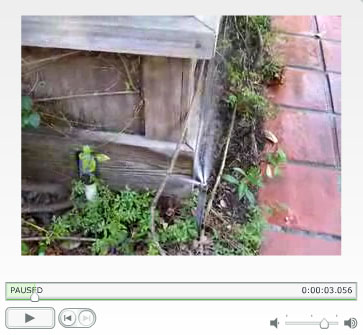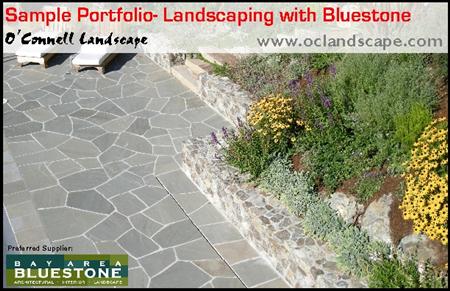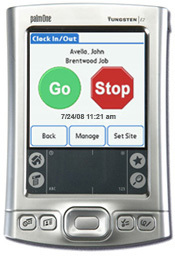We will be at the Marin Homeshow at the Civic Center this weekend Saturday and Sunday May 30-31. If you are planning on going to the show make sure to stop by our booth. We will be raffling off a free water feature installation.
Yearly Archives: 2009
Consider a Survey When Working Near Property Lines
There is an article in the Marin IJ today about homeowners in Mill Valley that build their landscaping and pool house on open space and MMWD land. Over 7,000 sq.ft. of improvements ended up in the Homestead Valley open space, sparking the outrage of neighbors and open space advocates.
This is a good example of why in many cases homeowners should consider surveys when working on fences, large parcels, or other landscaping near property boundaries. Should adjacent properties sell or if neighbors want to expand, encroachments can lead to frustrating legal conflicts and the possible removal of improvements.
From the Drawing Board- Fence Design
Here is a current project with a fence design we are working on in San Rafael. This is a typical 6′ plus 2′ trellis style fence, designed to give privacy, while at the same time using a top open panel to not being too visually imposing.

New Office Location
We have moved our administrative offices to an exciting new location in Petaluma. The address is: 3028 Petaluma Blvd North, Petaluma, CA 94952
We still have an office and construction yard in San Rafael, but this new office has more space and room for landscape demonstration areas and will allow us to better serve both our Marin and Sonoma clients. More details to come soon.
Our contact phone remains the same: (415) 462-9729 or you can dial our Sonoma County number (707) 313-5320.
Case Study- Commercial Landscape Services
While the majority of the new work we construct focuses on custom residential landscape construction, about 25% of our projects are commercial landscape installation work. Commercial installations carry with them their own set of challenges. We find that our design-build approach and project management services are especially valuable in these situations where we can manage complex projects involving multiple subcontractors, tight budget constraints and the needs of multiple stakeholders and end users.
A good case study of our commercial construction process is the Four Points Sheraton Hotel in San Rafael where we completed a pool courtyard renovation last year. The pool area for the Sheraton was outdated and unusable. The management and management company wanted a more usable space to serve as a better gathering place in the central courtyard of the hotel, and a place where outdoor meals could be served from the restaurant on-site.
We developed a renovation plan for the space the incorporated a custom designed two sided gas fireplace, with a central shade arbor that tied into the existing architectural detailing and gave an anchor to the space. The result transformed the outdoor dining experience at the restaurant, better incorporated the pool area into the rest of the hotel use areas, and is one of the most popular areas for people to gather at night around the fireplace.
View our Sheraton Portfolio to see more before and after images and details on this project.
Heritage Salvage- Good resource for recycled materials
With the high cost of quality lumber and reduced availability of good wood materials for building, Heritage Salvage in Petaluma is an excellent resource for recycled and salvaged building materials. Not only is salvaged lumber a more environmentally friendly option for exterior wood installations like fences, often you can find unique material that has more character than newly milled lumber. The other advantage to using salvaged material is finding sizes and dimensions of lumber no longer available. Their website has a good overview of current stock, and their yard is definitely worth a visit.
Will salvaged lumber be cheaper than building your project with new material? It depends on the application and how much treatment and labor is required for the particular project. In many cases though, salvaged lumber makes good aesthetic, environmental and financial sense.

Decomposed Granite Problems
A few weeks ago I was headed to a consultation for a client who wanted a decomposed granite patio installed. Earlier that day, I passed a front yard that was a classic example of some of the problems with decomposed granite installations. DG is a great material, but it is important to understand its limitations and maintenance requirements to keep it looking as good as the day it was installed.
Decomposed Granite’s Problems:
1- Rain and DG: DG is a combination of small pieces of granite gravel, and granite fines (basically granite sand). The fines is what allows DG to compact and makes it well suited for paths. The fines however, have a tendency to get muddy in winter. This is something to consider when designing paths that lead into a home, or something to be aware of with dogs and other pets that make leave DG prints inside.
2- Shady Areas and DG: Because DG has fines material and gets muddy, it also can grow moss or weeds that keep it from looking its best. Again, DG is not a maintenance free material like a concrete walkway. It needs to be raked to remove weeds or moss, and may need to be redressed with a little bit of new material and periodically recompacted.
3- Drainage and DG: Ideally, DG paths should be slightly crowned to make them drain better and prevent areas of standing water. DG paths also must be installed away from drainage flows like downspouts and dripping gutters and rooflines that will wash away the material.
We have written extensively in the past about the different types of DG and its properties- read our past blog articles for more information:
–Decomposed Granite Types
-Is Decomposed Granite the Best for Paths?
-Our Portfolio of Pathway Installations
Save Water with Irrigation Upgrades
Concerned about possible water rationing in the near future, a client in Ross that we have done work for over the years wanted to upgrade the old portions of her irrigation system to be more water efficient. Here is a video that shows a good example of an older system that was in need of replacement.

Italgreen- An Environmental Option for Synthetic Turf
With the increasing options available with synthetic turf, and the environmental benefits of not requiring watering, mowing, or fertilization, more people are considering synthetic turf alternatives. Italgreen is product now being carried locally that combines the benefits of removing natural turf, with an environmental material construction. Many of the current synthetic turfs combine various types of plastics to simulate a natural grass blade. There are some environmental concerns (most specifically with lead- see this Chronicle Story) with the long term effects of leaching or runoff from these products.
The manufacturer touts a number of benefits to their product. This type of turf has is constructed of a more environmentally friendly yarn construction, instead of plastic based blades. It also uses an organic granule infill instead of recycled rubber infill pellets. The results are a non toxic material, with better heat absorbtion and a softer feel.
Trying a New Smart Phone- The Samsung Saga
We love technology around the office, and what better way to embrace new technology than by upgrading to the newest and latest smartphone. This was my plan at least when ordering the new device, a Samsung Saga. One day later, in was in the box ready to be sent back (thanks to Verizon’s 30 day trial policy), and a Blackberry was ordered in its place. The problem- too much of a good thing. The Saga combines an optical mouse similar to the trackpad on a laptop, with a touchscreen, Palm Treo like stylus, and keyboard. This would all be great if you were using the phone as a complete PDA, and a laptop replacement, but not ideal for quick navigation and email on the go. None of these navigation methods worked flawlessly, and coming from the Blackberry like Motorola Q9, it was all too much technology.
Preparing Your Garden for Drought
Click here for an easy to read .pdf version of this article
Water agencies across California are bracing for a drought year, and either preparing or have already implemented water restrictions. As resources become more and more limited water districts are going to require more mandatory water savings measures. Landscape lawns and plants can be a major water user, but there are some simple steps you can take to make your garden more water efficient.
Take a look at your irrigation controller:
For many people their landscape controller goes untouched in a back corner of the garage, or is the exclusive domain of their gardener. Basic controller operation is easy; take some time to walk through your controller programming and basic functions. Most controllers have .pdf versions of their manuals online. Your controller needs to be adjusted seasonally based on temperature, rainfall and the water needs of your plants. While this can intimidating at first, once you get the hang of the water usage patterns for your garden, it is easy to make adjustments.
In Marin, MMWD has recommendations online for the amount to water plantings and lawns that is updated each week based on weather conditions. Use this as a starting point, and then make adjustments either up or down based on observation and the needs of your garden. For dormant periods in the winter and early spring for example, MMWD recommends not watering plants unless they shown signs of wilting.
There are also an increasing variety of technologically advanced sprinkler controllers that make automatic adjustments based on temperature, rainfall and humidity. Depending on the type, you can install a small localized weather station for your garden, or have data beamed directly to your controller. You can find an outstanding overview on Smart Controllers from the San Francisco Chronicle.
Upgrade Your Sprinkler System
1. Rain Sensors- If you don’t already have a rain sensor, these are devices that will automatically shut off watering when rainfall reaches a certain point such as 1/8″ or 1/4″. They are an easy way to manage watering during the rainy season without running to shut off your controller.
2. High Efficiency Irrigation- Converting existing planting beds from spray heads to drip irrigation can result in major water savings. Take this example, a water audit we performed for a client with a planting bed with 15 spray heads:
-Existing: 15 spray heads, average output per head 2.5 gallons per minute each
-Proposed: Replace with 45 drip emitters, average output per emitter .016 gallons per minute each
-Monthly Estimated Savings:Assume watering 3 times per week for 10 minutes (30 minutes per week, 130 minutes per month)
Existing sprinkler consumption: 4,875 gallons
New drip consumption: 97.5 gallons
While this is a simplified example, (the drip system may require a longer watering time per week) it goes to show how you can improve your watering efficiency dramatically by switching to a drip system with lower evaporation, lower output, and lower waste.
3. Next Generation sprayheads- For areas where drip irrigation isn’t a good fit, there is an array of new higher efficiency lower output sprinkler spray heads and rotors that are up to 50% more efficient than older models.
Xeriscape
Reducing your water consumption by eliminating high water use plants and lawns is an extremely effective way to curb water use. There are a variety of alternative lawn materials, and drought friendly plants that can help accomplish this. In addition to bold measures like tearing out your lawn, simple steps like adding bark or gravel mulch can help reduce evaporation and make the water that is applied to plants more effective. Read here our articles on alternative lawns, synthetic lawns, and view MMWD’s Water Wise Plant List.
Making these changes frequently require some effort and cost. But the work is rewarded by a more environmentally friendly garden, one that can better survive a drought. Given current weather patterns and strains on the water supply, making these changes now can better prepare your garden and home for water restrictions in the future.
For More Information:
Reference Manuals Online for Common Controller Types:
-Irritrol
-Toro
-Rain Bird
-Hunter
-Orbit
-Check out MMWD’s 10 Easy Ways to Conserve Water
–The Bay Friendly Landscape Program has an wealth of best practices information for saving water and reducing environmental impacts of your garden.
Landscaping with Bluestone
Bluestone is one of our favorite natural stone materials for landscape. Bluestone’s color range of blues and grays work great with most design schemes, its durable, and its available in multiple sizes for diverse applications.
Here is a new .pdf version of our bluestone installations and design applications.

Finding that Hard to Find Computer Part
We were reconfiguring some of the hardware in our office recently and needed a connector for one of our computer components. After not being able to find anything locally, we found the Cyberguys, a great website with all sorts of useful and ingenious gadgets for computers and around the house and office- definitely worth a look
How We Track Time on Projects
For years tracking time on our construction projects was a bit of a challenge. We used a paper time card with different activity codes for the construction activities on our various projects. Rather than a simple clock in, clock out, this is what is known as a time and attendance system. Last year we implemented a new digital time tracking system, Pocketclock by Exaktime. Exaktime has been developing time tracking solutions for a few years, but we found their Jobclock system, that used a special padlock that was placed on the jobsite, didn’t work well for the way our projects and crews were organized.
Recently, they released the Pocketclock system that was based on a Palm or Windows Mobile device. Rather than track time on paper, our employees enter their work actions on a PDA in the field. The difference has been noticeable. We can more easily track, analyze and bill our clients for the time we spend on projects, and it has streamlined our whole payroll process and simplified entering and bookkeeping tasks.
This a definitely worth a look for contractors or anyone who tracks individualized tasks out of a typical office environment.

Best of the Bay
The Chronicle and City Voter have announced their Bay List best of 2008 list of Bay Area companies in a variety of categories. These “Best Of” are a bit arbitrary and were create based on nomination, but this is an interesting list to browse though to find different local service companies.
